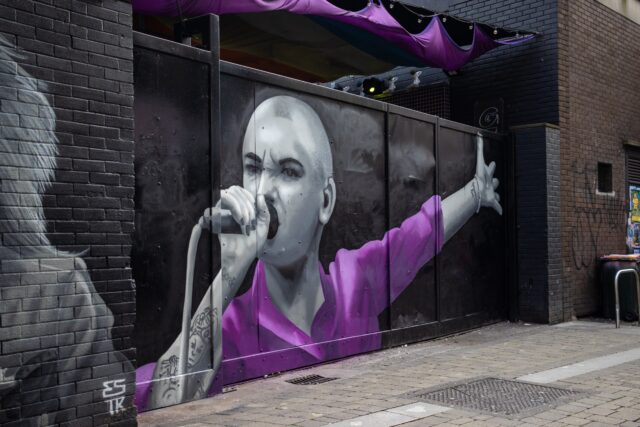Basic wage improves working conditions and well-being for Irish artists

A mural by Irish artist Sinead O'Connor in Dublin, Ireland. The mural was created by Emmalene Blake.
The initiative has been well received: over 17,000 Irish artists have applied in 2025 after the three-year trial period. 2000 artists can now look forward to receiving a basic salary from the Irish government of around €1400 per month, equivalent to around 10,500 Danish kroner.
The basic income trial for artists was intended to recognise artistic practice and artists' contribution to society, as well as to address income insecurity for artists and prevent them from leaving the artistic sector for financial reasons. This is according to Department of Culture, Communication and Sport in a press release about the scheme that will now be permanent.
The Basic Income trial showed important results
The trial period for BIA - Basic Income of The Arts - ran from 2022-2025 and has been extended to February 2026. Based on the three-year trial period, data has been collected on the 2000 BIA recipients and 1000 applicants who were not accepted into the programme.
The report shows that the programme reduced BIA recipients' symptoms of anxiety and depression, while the basic salary freed up 2.3 hours a week for research in their artistic practice. In addition, the artists spent an average of €333 more per month on equipment for their artistic practice.
In particular, it is worth highlighting that artists under the scheme saw an overall increase in income from artistic work of over €500 per month, while their income from non-artistic work decreased by €280 per month.
The scheme contributes to society's economy
The socio-economic analysis behind the trial shows that every euro invested by the Irish state in the BIA scheme created a total value of €1.39 for society. The analysis takes into account the economic, cultural and social benefits of the scheme.
Among other things, it points out that artists' increased earnings from artistic labour and their investments in materials and production contributed to economic activity, while lower incomes from other professions reflected the fact that more people were able to devote themselves to art full-time.
However, a significant part of the benefit came from improved psychological well-being among participants - a factor that, according to the report, had the greatest societal value.
Although Ireland and Denmark differ in many ways in their cultural support system and economy, the new basic salary for artists and the following reporting will be exciting to follow, says Sara Indrio, Chairperson of the Danish Artist Association:
"The Irish basic income for artists is particularly interesting because the reporting on the trial period has directly shown that, in addition to increased well-being among artists, there is a higher output of art, higher earnings for their work, more reinvestment and sales of cultural experiences. We'll be watching to see how the scheme works in the long term," she says.
You can read the full analysis of 'Basic Income for the Arts' from 2025 here.
Financial stress among music artists
Although there are many differences between the conditions for Danish and Irish artists, the issues that the basic salary in Ireland helps to solve are also relevant in Denmark.
Financial uncertainty and income instability are among the biggest sources of anxiety and stress in the music industry in Denmark. This is the conclusion of the 2024 report 'When Music Speaks', a study of the mental health of Danish musicians.
The study suggests that almost half of the music artists surveyed experience abnormally high levels of anxiety and that the instability of employment in the music industry is itself a major cause of what the researchers call 'financial stress'.
Read the full report here.
The criteria for participation in BIA
Applicants for the BIA, the Irish basic income for artists, must fulfil certain criteria, including documentation of their artistic practice, a certificate from relevant training or income from participation in the field.
As soon as an applicant is deemed qualified, they are anonymised and entered into the pool for a draw via software that is tasked with selecting a random, representative portion of the applicants. There is therefore no assessment of the artistic work or artistic expression itself, and in this way the basic salary is not similar to anything we have in Denmark.
Work scholarship for Danish artists
Every year in Denmark, the Danish Arts Foundation awards millions in working grants to artists across the arts, including composers, musicians, architects, film directors, visual artists, designers, dancers, performance artists and more.
I In 2025, 1252 artists received a total of over DKK 108 million.
It is part of the DKK 500 million that the Danish Arts Foundation gives to art projects in Denmark.
Sara Indrio, chairperson of the Danish Artist Association, is looking forward to seeing what the permanent scheme will mean for both the artists' output, but also the societal benefits of investing in the arts:
"The report from Ireland suggests that we should continue to invest more in the work of artists because it reflects positively on artists, cultural life and the economy. It also raises the question of whether we should invest more directly in the artists themselves," she says.
You can find all the recipients of the Danish Arts Foundation Working Grant from 2025 here.
Text by trade journalist Alberte Silberbrandt

